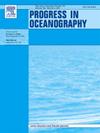跨陆架梯度浮游动物生物区功能特征
IF 3.6
3区 地球科学
Q1 OCEANOGRAPHY
引用次数: 0
摘要
利用基于性状的方法通过将物种分布与生物性状联系起来,补充了分类群落分析。对于海洋浮游动物,性状被用来识别物种之间的功能相似性,并量化浮游动物在食物网和生物地球化学循环中的作用。对浮游动物功能生物地理学的认识主要集中在桡足类和纬度梯度上,而对更广泛的浮游动物群落和跨陆架梯度的研究有限。本研究的目的是基于多种功能特征来检验跨陆架梯度上不同的浮游动物群落是否具有不同的功能。与之前的功能生物地理学研究相比,一个浮游动物特征数据库提供了更广泛的特征集,综合了东北亚北极太平洋浮游动物20年的监测数据。163种甲壳类和软体浮游动物首先被划分为10个功能类群。近海、深陆架、近岸和深峡湾生物区在功能群的相对组成、群落总性状值、群落特征加权均值和功能多样性指标上存在显著差异。此外,本研究还探索了在多个生物区域中发现的具有相似功能特征的组合,并描述了浮游动物功能多样性与生态系统功能关系的区域差异。生物区域的功能特征为解释海洋驱动因素如何影响浮游动物群落的功能特征以及改善环境变化如何影响特征分布和群落功能的预测提供了基础。本文章由计算机程序翻译,如有差异,请以英文原文为准。

Functional characteristics of zooplankton bioregions along the cross-shelf gradient
The use of trait-based approaches complements taxonomic community analysis by linking species distributions with organismal traits. For marine zooplankton, traits are used to identify functional similarities between species and to quantify the roles of zooplankton in the food web and biogeochemical cycles. Efforts in understanding the functional biogeography of zooplankton have generally focused on copepods and the latitudinal gradient, while investigations on the wider zooplankton community and the cross-shelf gradient are limited. The objective of this study was to test whether taxonomically distinct zooplankton communities along the cross-shelf gradient are functionally distinct based on multiple functional characteristics. Two decades of zooplankton monitoring data from the Northeast subarctic Pacific Ocean were synthesized with a zooplankton trait database that provides a more extensive set of traits compared to previous functional biogeography studies. The 163 species of crustacean and soft-bodied zooplankton were first categorized into ten functional groups. The Offshore, Deep Shelf, Nearshore, and Deep Fjord bioregions were found to significantly differ in the relative composition of functional groups, community total trait values, community weighted means of traits, and functional diversity metrics. This study additionally explored assemblages with similar functional characteristics that are found in multiple bioregions and described the regional differences in the relationship between functional diversity and ecosystem functioning for zooplankton. The functional characterization of the bioregions provides a foundation for explaining how oceanographic drivers influence the functional characteristics of zooplankton communities and for improving predictions on how environmental changes would influence the distribution of traits and community-level functioning.
求助全文
通过发布文献求助,成功后即可免费获取论文全文。
去求助
来源期刊

Progress in Oceanography
地学-海洋学
CiteScore
7.20
自引率
4.90%
发文量
138
审稿时长
3 months
期刊介绍:
Progress in Oceanography publishes the longer, more comprehensive papers that most oceanographers feel are necessary, on occasion, to do justice to their work. Contributions are generally either a review of an aspect of oceanography or a treatise on an expanding oceanographic subject. The articles cover the entire spectrum of disciplines within the science of oceanography. Occasionally volumes are devoted to collections of papers and conference proceedings of exceptional interest. Essential reading for all oceanographers.
 求助内容:
求助内容: 应助结果提醒方式:
应助结果提醒方式:


